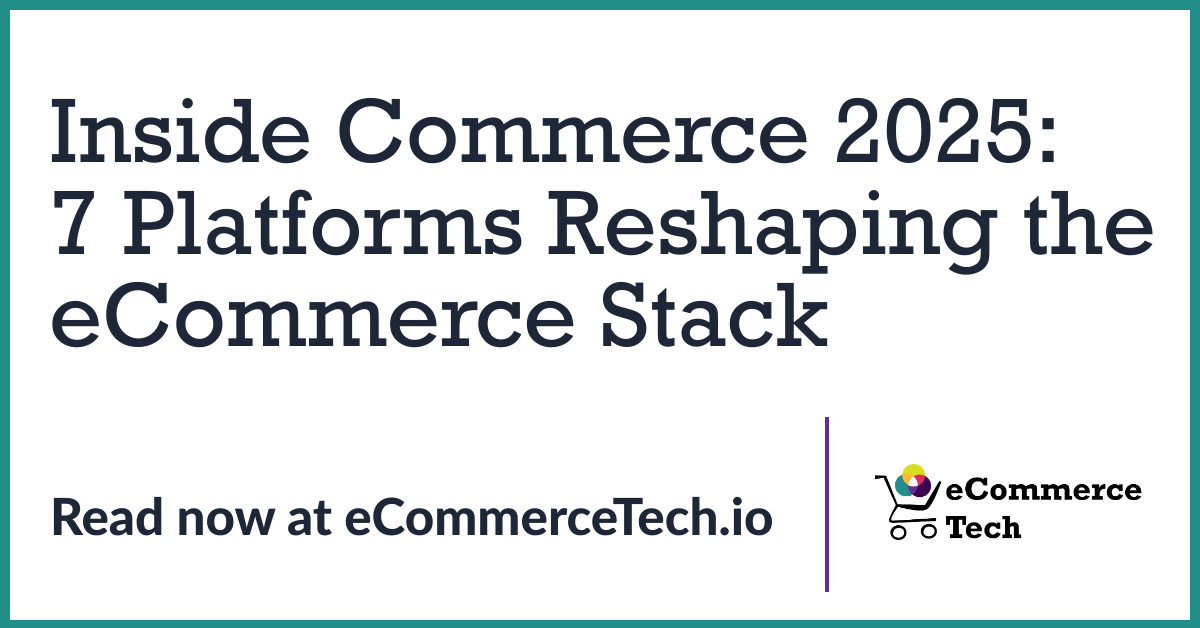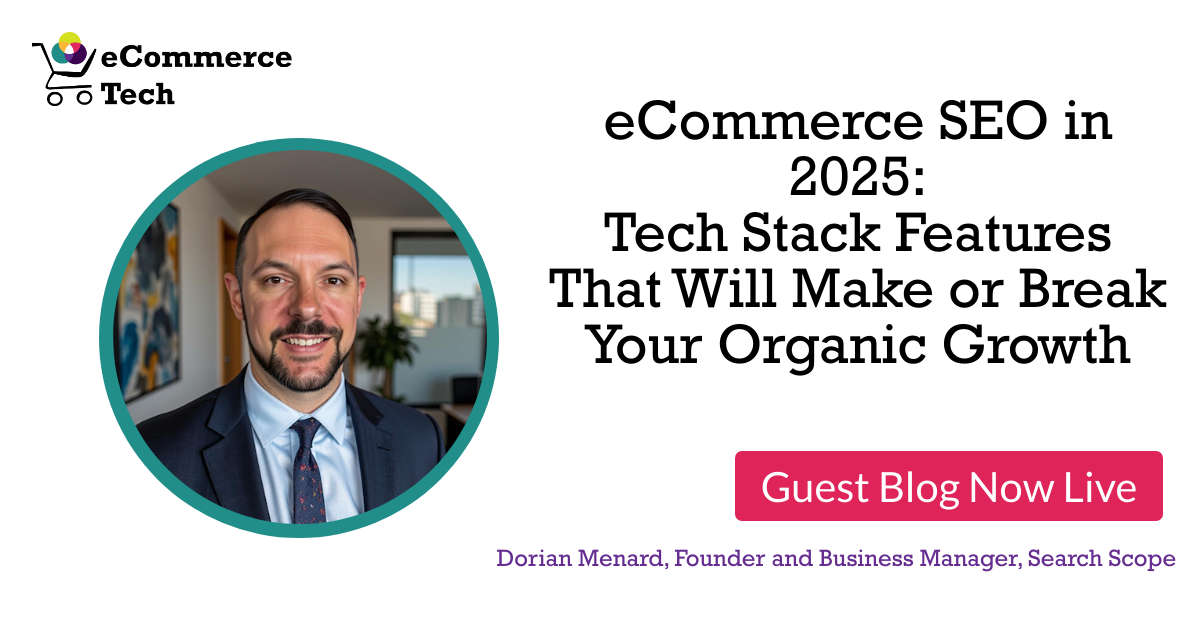eCommerce vendors are no longer just competing on features; they’re redefining what digital retail infrastructure looks like. With macroeconomic pressures, shifting customer behaviour, and AI entering the operational core of platforms, the second half of 2025 is poised for a reshuffle in who leads, who lags, and who reinvents.
Major platform players are now making high-stakes bets: B2B transformation, headless architecture, composable commerce, automation-as-default, and global-native tools. As more merchants look to modernise ageing systems or stretch leaner teams across more functionality, choosing the right stack is more critical than ever.
That’s why we always keep close tabs on what our friends over at the Inside Commerce Podcast are covering. We’re huge fans of the work James Gurd and Paul Rogers are doing. So when they dropped an epic new episode featuring leadership from seven of the most influential platforms in the space, we knew we had to break it down for you. Have a read, then give the full episode a listen. Trust us, it’s worth it.
Centra Prioritises Scalability for Fashion Brands Under Pressure
Guest: Jenny Xu, Product Marketing Manager
Centra is doubling down on its fashion-and-lifestyle-first position, aiming to become the operational OS for global brands navigating tighter margins and expanding wholesale demands. As rising acquisition costs and logistics strain budgets, Centra is focusing on simplifying global selling without compromising the tailored experiences fashion retailers demand.
Recent upgrades to its B2B showroom reflect a shift toward enabling self-serve, intuitive buyer journeys. Pricing flexibility is also being refined, with new tools for forward-planning discounts and protecting margins. Looking ahead, AI-powered translation features will lower the barrier for localisation, and a visual discount engine is in development to allow marketers to craft highly targeted promotions without developer help.
With momentum building in the UK and broader European markets, Centra is positioning itself as a purpose-built alternative to generalist platforms.
Shopline Scales Its All-in-One Vision with a Tech-Light Strategy
Guest: David Meakin, Commercial Director
Shopline’s bet? Most merchants don’t want endless third-party integrations; they want simplicity, speed, and something that works out of the box. That philosophy is reflected in their 60+ core modules, all tied together by AI and performance-minded architecture.
From AI-generated storefronts and loyalty programs to new 3.0 JavaScript themes that prioritise speed and campaign flexibility, Shopline is turning traditional site building on its head. Its focus is clearly on operational ease; merchandisers can now localise content, schedule seasonal campaigns, and preview storefront updates weeks without touching code.
With case study wins in electronics and home & garden retail, Shopline is building credibility as the go-to option for brands seeking international growth without the app sprawl.
BigCommerce Deepens Its Vertical Play with B2B Firepower
Guest: Andrew Norman, General Manager EMEA
BigCommerce is no longer trying to be everything to everyone. Instead, it’s zeroing in on verticals where its composable framework and B2B toolkit can shine: builders’ merchants, auto parts distributors, and home goods suppliers.
The platform’s Catalyst framework is gaining real traction, enabling headless and composable builds for merchants with complex ERP and channel orchestration needs. Meanwhile, Feedonomics is being baked deeper into the core product to give brands control over where and how their products show up across marketplaces.
Expect stronger investments in industry-specific features, including back-order logic, language/localisation support, and direct integrations with top B2B fulfilment systems. BigCommerce is moving into 2025 with a clearer focus and stronger infrastructure to match.
Shopify Doubles Down on Enterprise with AI and Unified Commerce
Guest: Benjamin Lang, Head of EMEA Partner Expansion
Shopify’s not content with dominating the D2C space. With its latest editions and AI tools, it’s making a serious run at the enterprise market, promising faster time to market, unified data control, and lower total cost of ownership.
The rollout of Sidekick AI adds a new layer of merchant support, assisting in everything from analytics to campaign planning. Horizon themes bring improved design flexibility, while CMS block generation makes it easier for teams to control visual content across regions.
The redesigned POS and expanded B2B features show Shopify’s intent to become a unified platform for omnichannel retailers. Enterprise clients are taking notice: Shopify is seeing traction with multi-location brands in beauty, fashion, and retail.
Remarkable Commerce Leans into Custom Flexibility for Mid-Market Growth
Guest: Brad Houldsworth, Strategy Director
Built for merchants outgrowing platforms like Magento, Remarkable Commerce is carving a niche as the quiet, capable partner for complex builds and modular upgrades.
The platform has invested heavily in its search engine infrastructure, blending Elastic and vector search to drive relevance. Its personalisation engine allows content-level customisation based on user behaviour, while backend flexibility means integrations and feature releases don’t require full-scale replatforming.
Beyond the platform, Remarkable also offers custom development services, often stepping in when other agencies can’t deliver. That blend of product and service is proving particularly effective for mid-sized brands facing legacy tech constraints and demanding content workflows.
Commerce Layer Targets Global-First Retail with Composable Precision
Guest: Filippo Conforti, Founder and CEO
Commerce Layer continues to fly under the radar, but for merchants prioritising global scale and technical flexibility, it’s increasingly on the short list.
With built-in multi-currency, multi-country capabilities and fully composable APIs, Commerce Layer is ideal for brands aiming to localise without duplicating effort. What sets it apart? Native support for conversational and agent-powered commerce, plus integrations with AI fulfilment workflows.
As merchants eye global growth and automation-driven scale, Commerce Layer’s lean, API-first model positions it as a serious contender in the enterprise build stack.
Scayle Commerce Engine Builds Quiet Infrastructure for Global Leaders
Guest: Gurpreet Kaur, Global Head of Product Marketing
Scayle doesn’t make noise; it builds power behind the curtain. Powering global-scale brands through modular infrastructure, Scayle is focused on solving complexity without bloated tooling.
Their product roadmap centres on marketplace readiness, advanced pricing logic, and customizable APIs that slot seamlessly into multi-region retail operations. While many platforms chase visibility, Scayle is doubling down on what enterprise brands quietly value most: control, scayle, and uptime.Want more? This recap only scratches the surface. Listen to the full Inside Commerce episode to catch every insight straight from the source. Also, if you’re looking for expert tips and tactics on all things eCommerce—growth, retention, tech and lots more subscribe to our eCommerce Podcasts list








